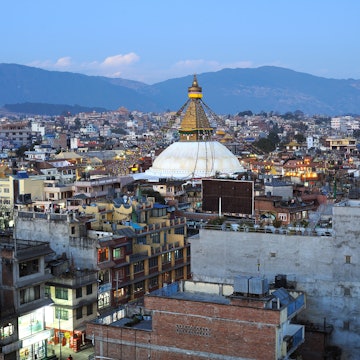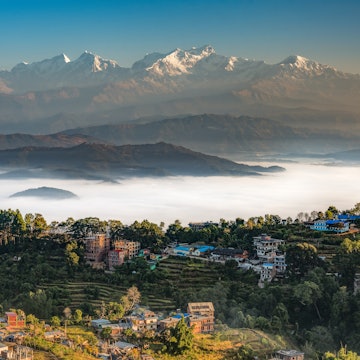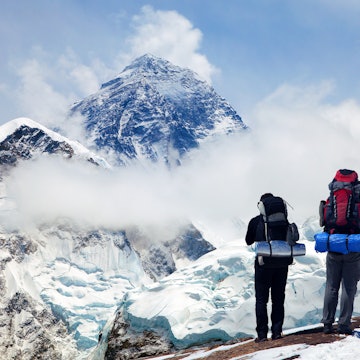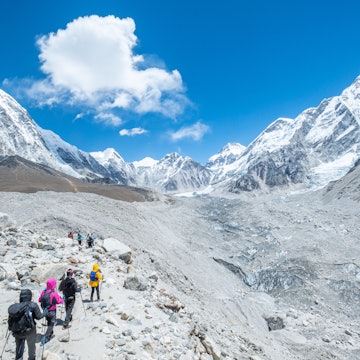

Everything you need to know about sustainability as you plan your two-week trek © Westend61 / Getty Images
Taking in mountain monasteries, mighty glaciers and up-close views of the world’s highest peak, the trek to Everest Base Camp in Nepal is one of the world’s top adventures. But it can get pretty crowded on the roof of the world.
At the height of the trekking season, dozens of flights drop in daily to the precariously balanced airstrip at Lukla, starting point for the two-week trek to the mountaineers’ camp at the foot of Mt Everest – or Sagarmatha, as it’s known in Nepal.
Along the route, an efficient production line has been established to deliver trekkers to their destination, with lodges offering hot showers, internet access, mobile phone charging, apple-pie desserts and bottled beer. It’s a business that has brought prosperity to mountain communities, but at a cost to the pristine environment of the Himalaya.
The good news is that travelers can do a lot to make their trek to Everest Base Camp more sustainable. Here's how.

Take a less-crowded route to ease the traffic
Photos of the gridlock at the summit of Everest during the 2019 climbing season pushed overtourism on Everest to the top of international newsfeeds, but most of the estimated 40,000 people who visit Everest Base Camp (EBC) every year are trekkers, who bring an estimated US$300 million to the Nepali economy every year.
The crowds have created huge demand for resources, and significant problems with rubbish. Discarded plastic water bottles and food wrappers dot the landscape and hillsides stand denuded of trees, stripped to provide firewood to heat meals and water for the trekking masses. It’s a sad state of affairs for one of Nepal’s oldest national parks.
You could always trek elsewhere, but you can also ease the pressure on the Everest region by following less crowded trails. The Chhukung Valley east of Pheriche, the Bhote Kosi Valley west of Namche Bazaar, and the Dudh Kosi Valley north of Namche Bazaar at Gokyo all see fewer trekkers than the main approach route to EBC.
You can link them all on the spectacular and challenging Three Passes trek, and there’s plenty you can do to help the Himalaya when you get here.
Read more: Everest Base Camp trek in detail: alternative routes & side trips

Pick up a collection bag to collect waste
The Sagarmatha Pollution Control Committee (SPCC) was established in 1991 to manage the growing waste problem in the Everest region and has done its best to improve the conditions on the mountain. Volunteers removed 10.3 tons of rubbish from the slopes of Everest and the approach to Everest Base Camp in 2019, making just a small dent in Everest’s waste mountain.
To help, the SPCC has erected more than 100 rubbish bins at rest points on trekking trails in the Everest Region. “Please use these bins while trekking,” urges Yangji Doma Sherpa from the SPCC. “And take batteries and medicines back to your own country as we don’t have a proper management system for this type of waste.”
“It’s very helpful if trekkers remind their guides and porters not to litter on the trails while trekking with them,” advises Yangji.
Picking up litter while you trek will also help, says record-breaking Nepali mountaineer Nirmal Purja, whose ascents were the subject of the hit Netflix documentary 14 Peaks: Nothing is Impossible. “The most important thing that every trekker can do is take a litter bag. You can put any rubbish in there, however big or small, and if you bring it down to Kathmandu, it can be recycled.”
Read more: Nirmal Purja: The Nepali mountaineer reclaiming the Himalaya
One easy win is to join SPCC’s Carry Me Back campaign to remove empty aluminum cans and polyethylene terephthalate (PET) drinks bottles from the foothills. Travelers can pick up collection bags from the SPCC in Namche Bazaar and drop off bags full of cans and bottles at Lukla Airport when leaving the Everest region.

Eating local matters a lot here
It also pays to consider what you eat. “We advise trekkers to eat local foods as much as possible,” says Yangji Doma Sherpa. “Imported food items are usually packed in plastic, tin or glass, adding to the volume of waste in the region. We also suggest that trekkers use their own water purifying system or drink boiled water instead of bottled water during their trek.”
It’s sound advice – single-use plastics have been banned on Everest since 2020, but bottles more than 30 microns in width are still allowed, and the legacy of the many years before the ban can be seen in stream beds and undergrowth across the Himalaya.

Be mindful of your guides and their welfare
Trekking has brought wealth to the Everest region but also problems, including increased demand for limited resources and overdependence on tourism. Porters, guides and lodge owners often face severe financial difficulty during downturns in tourism, such as the one caused by the COVID-19 pandemic.
Ian Wall, CEO of the Kathmandu Environmental Education Project, urges trekkers to consider their responsibilities towards the people who help them on the trails. “Remember guides and porters are human beings. It’s a fallacy that they don’t suffer from altitude or hypothermia problems, so make sure that they have the right clothing, warm accommodation and appropriate food.”
“Also make sure they have insurance. If things go wrong, it is the guides and porters who make sure you get the appropriate help, so do the same for them.”
Responsible trekking agencies provide insurance for their porters and guides, following the guidelines on fair wages and life and income protection insurance laid down by the Trekking Agents Association of Nepal and Nepali trade unions.
If you are hiring a guide or porter independently, ensure their daily wage is enough to cover insurance as well as their fees and living costs, and insist that they take out coverage (Nepali insurance companies have dedicated policies for trekking industry workers). Do not underestimate the effect that an injury or loss of income can have on the families of porters and guides.
When choosing support staff, keep the concept of a fair wage in mind, rather than looking for the cheapest price. “Whether you’re hiring porters or guides directly or through a trekking agency, the most important thing is to ensure that they’re fairly paid,” agrees Abhi Shrestha of Nepali agency Rural Heritage, who has decades of experience of working with rural communities.

Consider the way you contribute to the locals
Many trekkers want to help local people while trekking, but there’s a right way and wrong way to go about this. Handing out gifts at random while you trek is unlikely to make a lasting difference, compared to making donations through a local or international charity or community project.
“Over the years trekkers have delighted in giving children pens, money and chocolate,” cautions Ian Wall from KEEP. “Over time, this has generated a culture of begging, especially in remote areas. This is not good for children and it can spoil the experience of interacting with local people.”
“Instead, give your donations of books, pens, pencils etc to local schools or the village Ama Group (run by local mothers) so your donation can benefit a whole class or school of children, not just one.”
You could even sponsor a Nepali child throughout their education through organizations such as Plan UK and Save the Children. “Education is the key,” insists Nirmal Purja. “Rather than donating all this stuff, donating an education could change a whole life.”
Donating trekking gear that you don’t need any more at the end of the trek can also be helpful. It’s shocking how many porters cross the Himalaya in flip-flops while their clients wear $300 trekking boots. KEEP is one of several organizations that distributes donated gear to mountain communities.
Read more: How to choose a responsible travel operator

Reduce your carbon footprint by taking the long route
One of the best things you can do to help the Everest region is to reduce your carbon footprint. The Himalayan region is particularly vulnerable to climate change, with melting glaciers swelling mountain lakes to dangerous levels, glacial lake outburst floods are becoming increasingly common, threatening mountain communities, hydroelectric plants and infrastructure downstream.
When it comes to practical steps, the first thing to consider is your air travel. With the expense and time commitment involved in traveling overland to Nepal, most people will continue to reach Nepal by air, but cutting out domestic flights is one way to reduce your carbon footprint.
The flight to Lukla takes less than 30 minutes, but it’s possible to trek up to Lukla following a week-long trail that used to be the main approach route for mountaineers, starting at Shivalaya near Jiri – accessible by bus from Kathmandu.
An alternative route starts at Tumlingtar, nine days east of Lukla, which also marks the starting point for treks to Makalu, the world’s fifth highest mountain. On either route, you’ll see a different side to the Himalaya, passing through villages that are more focused on farming than the trekking industry.
Remember your firewood footprint, seek out the solar
Reducing the amount of firewood you are responsible for is another positive step. Avoid firewood-heated hot water and eat the same food as lodge owners are cooking for themselves, rather than insisting on a different meal. The communal stove that keeps lodges warm is less of a worry – it’s usually powered by yak dung.
“If you are camping, insist on using kerosene for cooking, and if you stay in lodges, always have a quick look at the roof before you book in,” recommends Ian Wall at KEEP. “Are they using solar energy to heat water? If not, consider moving on to the next lodge.”
Growing numbers of lodges have solar panels and many are turning to LPG gas for cooking, but if the only option for an overnight stay is a lodge that uses firewood, wash in cold water or wait till you reach a lodge that has solar power. Nobody is going to judge you for not smelling like a rose garden if you’ve been walking up mountains all day.
You might also like:
The Nepali mountaineer reclaiming the Himalaya
How to plan your dream trip to the Himalayas
How to trek to Everest Base Camp
Safety recommendations and restrictions during a pandemic can change rapidly. Lonely Planet recommends that travelers always check with local authorities for up-to-date guidance before traveling during COVID-19.
















